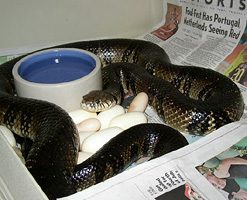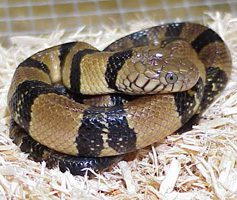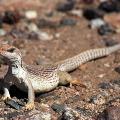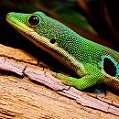
Cobra water ringed
The water ringed cobra (Boulengerina annulata) is a surprisingly secretive snake, in the rarest cases showing itself to people. There is another related species – Christie’s water cobra. And there are no more such animals in the world. Data on the habitat of the ringed cobra are quite contradictory, perhaps precisely because of its rarity. Some scientists say that the snake prefers small reservoirs, others that it lives in large rivers. However, only one thing is known for sure – the life of the water ringed cobra is closely connected with the aquatic environment. At the same time, it does not belong to the family of sea snakes (Hydrophidae), but is classified as a separate group of water cobras (Boulengerina) from the family of aspids (Elapidae). Although the coloration of the rings is still more characteristic of various genera of sea snakes. Like other cobras, the ringed water snake is endowed with a swollen neck area – a hood. It is called ringed because of the wide black rings located throughout the body. This cobra is a fairly large and intimidating species, one of the largest cobras in Africa, living only on this continent. And of course, it is also deadly poisonous.
Contents
Classification
Kingdom: Animals
Type: Chord
Subtype: Vertebrates
Class: Reptiles
Order: Scaly
Suborder: Snakes
Family: Asps
Genus: Water cobras
Species: Ringed water cobra Boulengerina annulata
Appearance
 The water ringed cobra has a dense physique and bright, contrasting coloration. The main color of the upper body is yellow-brown, sometimes it has an orange, gray and reddish tint. The underside of the body is pale yellow, and the tail is usually entirely black. And of course, do not forget about the thick black rings all over the body. By the way, these rings are found only in snakes living in West Africa, but the cobras of the central part of the continent have rings only in the cervical part of the body. Sometimes the ringed water cobra is confused with the similar giant Brazilian snake (Hydrodynastes gigas). Indeed, outwardly, these snakes are similar, they even called it a false water cobra. However, they have a completely different, non-overlapping habitat.
The water ringed cobra has a dense physique and bright, contrasting coloration. The main color of the upper body is yellow-brown, sometimes it has an orange, gray and reddish tint. The underside of the body is pale yellow, and the tail is usually entirely black. And of course, do not forget about the thick black rings all over the body. By the way, these rings are found only in snakes living in West Africa, but the cobras of the central part of the continent have rings only in the cervical part of the body. Sometimes the ringed water cobra is confused with the similar giant Brazilian snake (Hydrodynastes gigas). Indeed, outwardly, these snakes are similar, they even called it a false water cobra. However, they have a completely different, non-overlapping habitat.
The head of the water ringed cobra is small, round and slightly flattened, slightly wider than the body itself. The eyes are large with round pupils. The fangs, like those of all aspids, are located in the front of the upper jaw, but on top behind them, like the primitive representatives of the family, there are several more small teeth. In terms of size, the water ringed cobra competes with other large African cobras, such as the Egyptian or eastern tree cobra. In length, its dimensions are 1 – 5 meters. The shape of the body of the water ringed cobra can be called overweight, cylindrical, tapering towards the tail. The skin of this snake is smooth and shiny, it is very much appreciated by snake catchers, being used for the manufacture of various expensive products, as, in principle, the skin of other water snakes. The head of the water ringed cobra is markedly different from the body, and during anxiety or aggression, the hood immediately swells behind it.
Distribution and habitation
 As the name implies, the ringed water cobra lives in the waters of Equatorial Africa. Moreover, as already mentioned, information about its habitats varies. Some zoologists “settle” this cobra in large rivers and lakes, others – in small rivers and swamps. This particular species inhabits water bodies from Cameroon and Gabon to lakes such as Tanganyika and Nyasa. Here are the main African states where the water ringed cobra lives: Cameroon, Gabon, Congo, Central African Republic, Tanzania, Equatorial Guinea, Rwanda, Burundi and Zambia. Another type of water cobra – the already mentioned Christie’s cobra is found in the reservoirs of the western part of the Congo. Very rarely, the ringed water cobra can be found far from the water, for example, on forested plains or open beaches with sandbanks. Wherever this snake settles, it chooses places well hidden from prying eyes.
As the name implies, the ringed water cobra lives in the waters of Equatorial Africa. Moreover, as already mentioned, information about its habitats varies. Some zoologists “settle” this cobra in large rivers and lakes, others – in small rivers and swamps. This particular species inhabits water bodies from Cameroon and Gabon to lakes such as Tanganyika and Nyasa. Here are the main African states where the water ringed cobra lives: Cameroon, Gabon, Congo, Central African Republic, Tanzania, Equatorial Guinea, Rwanda, Burundi and Zambia. Another type of water cobra – the already mentioned Christie’s cobra is found in the reservoirs of the western part of the Congo. Very rarely, the ringed water cobra can be found far from the water, for example, on forested plains or open beaches with sandbanks. Wherever this snake settles, it chooses places well hidden from prying eyes.
Behavior and lifestyle
 There are also different information about the activity of the water ringed cobra, however, this snake still shows great activity during the day, although it can also hunt at night. Like all asps, the ringed water cobra is not aggressive, unlike, for example, the Egyptian cobra. It is able to bite only in case of serious danger, and usually prefers to hide from it in the water. Ringed water cobra is able to dive to a depth of 7 meters and spend more than 10 minutes under water in one dive. She swims well, but on land she becomes slow. Therefore, if the danger caught the water ringed cobra in the air, then it would prefer to hide among the rocks, in some hole, under the roots of coastal vegetation, and even under various artificial structures, such as bridges and piers. If it was not possible to hide, then the ringed water cobra takes a threatening pose, raising the front of the body high, puffing out the hood and hissing loudly. But she will never rush at a person first, for this she needs to be properly provoked. In the water, the ringed cobra very quickly swims away from the enemy. The bite of this snake is fatal to humans, but the effect of its venom is not well understood, especially since the venoms of various cobras differ in composition, toxicity and antigenic properties. It is only known that the bite of the water ringed cobra itself is quite traumatic and can cause necrosis, and the poison is most often characterized by a paralytic effect.
There are also different information about the activity of the water ringed cobra, however, this snake still shows great activity during the day, although it can also hunt at night. Like all asps, the ringed water cobra is not aggressive, unlike, for example, the Egyptian cobra. It is able to bite only in case of serious danger, and usually prefers to hide from it in the water. Ringed water cobra is able to dive to a depth of 7 meters and spend more than 10 minutes under water in one dive. She swims well, but on land she becomes slow. Therefore, if the danger caught the water ringed cobra in the air, then it would prefer to hide among the rocks, in some hole, under the roots of coastal vegetation, and even under various artificial structures, such as bridges and piers. If it was not possible to hide, then the ringed water cobra takes a threatening pose, raising the front of the body high, puffing out the hood and hissing loudly. But she will never rush at a person first, for this she needs to be properly provoked. In the water, the ringed cobra very quickly swims away from the enemy. The bite of this snake is fatal to humans, but the effect of its venom is not well understood, especially since the venoms of various cobras differ in composition, toxicity and antigenic properties. It is only known that the bite of the water ringed cobra itself is quite traumatic and can cause necrosis, and the poison is most often characterized by a paralytic effect.
Food
In nature, the water ringed cobra feeds on live fish, which it hunts. By the way, her diet ensures the normal reproduction of the snake. To date, under artificial conditions, offspring have been achieved from this cobra only once – in the Moscow Zoo. Zookeepers fooled a couple of snakes by feeding them mice coated with fish. But to reproduce their own kind to these water ringed cobras happened only once in 10 years of life in captivity. In addition to fish in nature, the water ringed cobra sometimes catches amphibians, such as frogs and toads. And besides the Moscow Zoo, this snake still lives only in Washington, but there it has not yet acquired the ability to reproduce.
Reproduction
There is surprisingly little information about the reproduction of water ringed cobras. It is not known exactly where this snake lays eggs – in shallow water or still on land, how many eggs are typical for it, what is the incubation period. As already mentioned, this species is quite rare in captivity, only in two zoos in the world. However, scientists still managed to make some observations of the snake. For example, it is known that the water ringed cobra, like other asps, is oviparous. Her serpents are born poisonous. The young are fed with fish fry. And during the mating season, males tend to arrange tournaments to earn the favor of the female. Moreover, they, like, for example, coral asps, do not practice group mating. And the victorious male retires with the female. The born water ringed cobras first enter the water only after a week of life, and the first time is mainly spent on land. Moreover, they arrange a trial swim only after the first molt. However, all these data were obtained in captivity, so they can only be trusted relatively, because it often happens that animals change their behavior in artificial conditions.
Sources of
http://www.floranimal.ru/
http://en.wikipedia.org
http://big-snake.narod.ru
http://ours-nature.ru/
http://www.utro.org/
http://commons.wikimedia.org/





